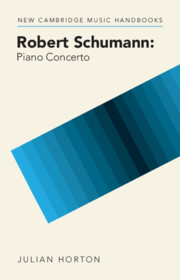91 results
2 - The Genesis of Schumann’s Piano Concerto
-
- Book:
- Robert Schumann: Piano Concerto
- Published online:
- 30 November 2023
- Print publication:
- 30 November 2023, pp 45-82
-
- Chapter
- Export citation
5 - Reception and Legacy
-
- Book:
- Robert Schumann: Piano Concerto
- Published online:
- 30 November 2023
- Print publication:
- 30 November 2023, pp 146-177
-
- Chapter
- Export citation
Tables
-
- Book:
- Robert Schumann: Piano Concerto
- Published online:
- 30 November 2023
- Print publication:
- 30 November 2023, pp ix-ix
-
- Chapter
- Export citation

Robert Schumann: Piano Concerto
-
- Published online:
- 30 November 2023
- Print publication:
- 30 November 2023
Acknowledgements
-
- Book:
- Robert Schumann: Piano Concerto
- Published online:
- 30 November 2023
- Print publication:
- 30 November 2023, pp xiii-xiv
-
- Chapter
- Export citation
Dedication
-
- Book:
- Robert Schumann: Piano Concerto
- Published online:
- 30 November 2023
- Print publication:
- 30 November 2023, pp v-vi
-
- Chapter
- Export citation
Introduction
-
- Book:
- Robert Schumann: Piano Concerto
- Published online:
- 30 November 2023
- Print publication:
- 30 November 2023, pp 1-10
-
- Chapter
- Export citation
Appendices
-
- Book:
- Robert Schumann: Piano Concerto
- Published online:
- 30 November 2023
- Print publication:
- 30 November 2023, pp 178-193
-
- Chapter
- Export citation
1 - Rethinking the Romantic Piano Concerto
-
- Book:
- Robert Schumann: Piano Concerto
- Published online:
- 30 November 2023
- Print publication:
- 30 November 2023, pp 11-44
-
- Chapter
- Export citation
Copyright page
-
- Book:
- Robert Schumann: Piano Concerto
- Published online:
- 30 November 2023
- Print publication:
- 30 November 2023, pp iv-iv
-
- Chapter
- Export citation
Music Examples
-
- Book:
- Robert Schumann: Piano Concerto
- Published online:
- 30 November 2023
- Print publication:
- 30 November 2023, pp x-xii
-
- Chapter
- Export citation
Appendix II - Discography
-
- Book:
- Robert Schumann: Piano Concerto
- Published online:
- 30 November 2023
- Print publication:
- 30 November 2023, pp 181-193
-
- Chapter
- Export citation
Index
-
- Book:
- Robert Schumann: Piano Concerto
- Published online:
- 30 November 2023
- Print publication:
- 30 November 2023, pp 201-204
-
- Chapter
- Export citation
Contents
-
- Book:
- Robert Schumann: Piano Concerto
- Published online:
- 30 November 2023
- Print publication:
- 30 November 2023, pp vii-vii
-
- Chapter
- Export citation
3 - Analysis (1): The First Movement
-
- Book:
- Robert Schumann: Piano Concerto
- Published online:
- 30 November 2023
- Print publication:
- 30 November 2023, pp 83-114
-
- Chapter
- Export citation
Figures
-
- Book:
- Robert Schumann: Piano Concerto
- Published online:
- 30 November 2023
- Print publication:
- 30 November 2023, pp viii-viii
-
- Chapter
- Export citation
Appendix I - Glossary of Technical Terms and Symbols
-
- Book:
- Robert Schumann: Piano Concerto
- Published online:
- 30 November 2023
- Print publication:
- 30 November 2023, pp 178-180
-
- Chapter
- Export citation
Bibliography
-
- Book:
- Robert Schumann: Piano Concerto
- Published online:
- 30 November 2023
- Print publication:
- 30 November 2023, pp 194-200
-
- Chapter
- Export citation
4 - Analysis (2): The Slow Movement and Rondo Finale
-
- Book:
- Robert Schumann: Piano Concerto
- Published online:
- 30 November 2023
- Print publication:
- 30 November 2023, pp 115-145
-
- Chapter
- Export citation
14 - Romantic Languages
- from Part IV - Practices
-
-
- Book:
- The Cambridge Companion to Music and Romanticism
- Published online:
- 06 August 2021
- Print publication:
- 26 August 2021, pp 231-257
-
- Chapter
- Export citation



